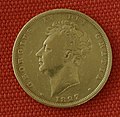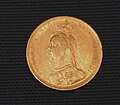Sovereign
| Sovereign | |
|---|---|
| Face value: | 1 pound sterling |
| Metal: | 91.67% Au |
| Fine weight: | 7.322381 g |
| Gross weight: | 7.98805 g |
| Diameter: | 22.05 mm |
| Thickness: | 1.52 mm |
| Edge: | corrugated |
| Embossing years: | 1817–1917, 1925, 1957-today |
| front | |

|
|
| Motive: | British ruling monarch |
| back | |

|
|
| Motive: | Saint George with a lance and kite |
| Designer: | Benedetto Pistrucci |
| Draft date: | 1817 |
When Sovereign is the nominal an English gold coin , which Henry VII. For the first time in 1489 minted. In the 17th and 18th centuries , the sovereign was first replaced by the Laurel , later by the Unite and the Guinee .
The minting of this gold coin with a face value of one pound sterling at 20 shillings was resumed in 1817. Since then, sovereigns have had a gross weight of 7.98805 g and a fineness of 22 carats (916⅔ / 1000). The era of sovereigns as a means of payment ended first in Great Britain during the First World War in 1917 and in South Africa with the abolition of gold cover in 1932. In addition to London, the minting locations were mainly cities in Commonwealth countries with their own gold deposits: Ottawa , Sydney , Melbourne , Perth , Bombay and Pretoria .
From 1957, minting was resumed as an investment coin . As such, the sovereign is also popular outside of the UK.
layout
back
- Different backs
The reverse has shown - with a few interruptions - St. George fighting the dragon since 1817 , based on a design by Benedetto Pistrucci . In the period from 1830 to 1871, only the coat of arms of the United Kingdom was depicted on the reverse. The designer of this was William Wyon. Between 1871 and 1887 the coat of arms and the St. George motif were coined. After the opening of the British mint in Sydney in 1853, a third, different coin reverse was minted there until 1870. What is very interesting about these coins is the alloy, which, unlike the other sovereigns, does not consist of a gold / copper alloy, but rather a gold / silver alloy. For this reason, these coins were very often melted down due to the higher raw material value. Another exception is that the face value “ONE SOVEREIGN”, the mint “SYDNEY MINT” and also the country Australia (which only existed half a century later) was on the reverse.
front
- Different fronts
The front shows a head image of the respective regent in side view. The direction of view changes with the regents: either to the left or to the right. There are several representations of some regents, e.g. B. Victoria, who ruled for 64 years, adorns the front of the coin in five different variations (always looking to the left).
history
Since 1817, sovereigns have been minted in accordance with the provisions of the 1816 Coin Act. They have a gross weight of 7.988052 g (according to the original definition; the 1971 Coin Act set the standard at exactly 7.98805 g.). The fine weight of 7.322381 g corresponds to 0.235420 (exact: 1320/5607) troy ounces or 113.0016 English grains (according to the original specification; the actual gold content may vary slightly due to permitted tolerances and abrasion.)
Until the First World War , the sovereign coins were completely normal coins in circulation. They were the curant coins of the British gold standard currency . In the course of the First World War, these coins disappeared from circulation and were replaced by paper money, which in fact became investment coins. The sovereigns were now traded with a premium at the paper pound and the silver and bronze divisional coins .
When the gold value of the sovereigns rose noticeably above the paper pound rate, many of them were melted down. Therefore, the collector's value of the most minted gold coin in the world (over 1.5 billion sovereigns have been minted so far) can now be higher for coins from minting years and mints with very high editions than for those from earlier minting years.
For example, the gold sovereigns that were last struck in London in 1917 were paid for as payment for armaments to the USA. These were stored in Fort Knox until they were melted down into gold bars in 1934 . Coins from this issue, which occasionally came into circulation, therefore have a very high collector's value; However, there are a lot of counterfeits here. For example, the mint mark was removed from the coins minted in the colonies in 1917. This mintmark was only placed on the coins minted in the colonies, not on the London coins.
Sovereigns were minted with the corresponding mint marks in the following colonies :
| Mint mark | Minting location |
|---|---|
| M. | Melbourne |
| S. | Sydney |
| C. | Ottawa (Canada) |
| P | Perth |
| SA | Pretoria (South Africa) |
| I. | Bombay only in 1918, but also Delhi (India) from 2013-2016 |
The mint mark is stamped on the coins, which show St. George fighting the dragon in the lapel, in the middle of the stylized base (above the year), on older it is on the front (sovereigns below Victoria), and on Coins with the coat of arms in the lapel, the mint mark is under the top of the coat of arms.
After the end of the First World War, the sovereign was only minted in the British colonies - with the exception of the years 1925 and 1937. The rarest sovereign was minted in 1937 - as Edward VIII abdicated before the sovereign with his portrait was issued only 3 copies have been minted. In addition, a few sovereigns were minted with the image of George VI in 1937. The last sovereign minted in large quantities for the time being came from South Africa in 1932. Between 1949 and 1952, the Royal Mint minted sovereigns again for the first time since 1925, but one simply used the stamps from the 1925 vintage with the portrait of George Vs (died 1936), something that collectors at the time raised, the vintage was considered rare until then. With the exception of 1953 (4 pieces), English sovereigns with the likeness of the respective regent were minted again from 1957.
All sovereigns (regardless of their year of issue) are still formally valid today. Their face value is still 1 pound sterling. The value of gold today is many times the purchasing power of today's (paper) pound.
variants
Half and double sovereigns as well as five pound coins were minted according to the pattern of the sovereign, whereby the 2 and 5 pound coins were only issued in sets as collector coins. The semi-sovereigns, on the other hand, were minted for circulation in parallel to the normal sovereign.
The gross weight of a half sovereign is 3.994025 grams, that of the double sovereign is 15.9761 grams, and the 5 pound sovereign weighs 39.94025 grams.
The South African 1 and 2 rand coins minted between 1963 and 1983 correspond in size, weight and fineness to the half or standard sovereigns, the same applies to the Saudi Arabian Guinea gold coins from 1950 and 1957 and the Peruvian Libra coins in execution 1 Libra (corresponds to the Sovereign), 1/2 and 1/5 Libra. The Persian Pahlevi coins also contain 7.32 grams of gold, but are slightly larger because they were minted from 900 gold.
literature
- René Frank : Gold coins of the 19th and 20th centuries . Part 3: The British sovereign and half-sovereign - probably the most famous gold coins in the world. In: money trend 38, 2006, 4, ZDB -ID 630026-1 , pp. 1–10, (PDF; 985 kB) .
- Tyll Kroha: Large encyclopedia of numismatics . Bertelsmann-Lexikon-Verlag, Gütersloh 1997, ISBN 3-577-10554-2
- Günther Schön, Gerhard Schön: World coin catalog 20th century. From 1900 to 2002 . 32nd completely revised and expanded edition. Battenberg Verlag, Munich 2003, ISBN 3-89441-501-0
Individual evidence
- ^ Coinage Act 1971 . HMSO , London 1971, ISBN 0-10-542471-4 , p. 9.











